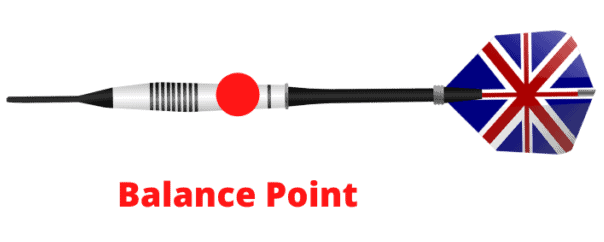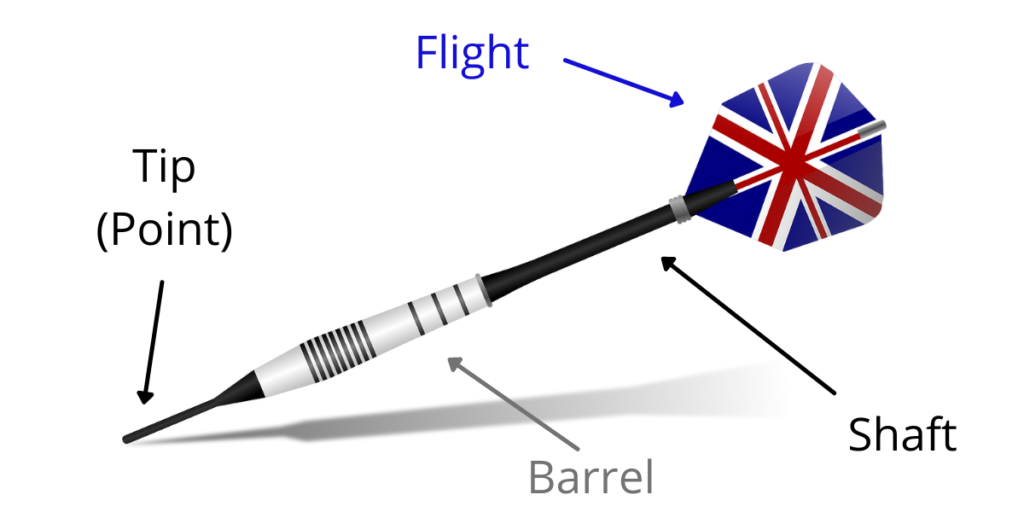Throwing a dart perfectly straight is rare, even if you’re a professional. Most players experience some wobble when their dart is travelling towards the board, which is commonly referred to as fishtailing. In this article, I’ll explain what fishtailing is, why it’s a problem, common causes and solutions so you can improve your scores.
What is Fishtailing in Darts?
Fishtailing in darts is also known as wobbling. It refers to lateral movement of the dart during its flight path where the flight moves from side to side. The issue with fishtailing is that it leads to inconsistency in the darts flight path which makes it more difficult to throw accurately and repeatedly.
Some amount of wobble is fine and it’s almost impossible to eliminate it completely, but excessive wobbling is an issue that should be addressed.

What Causes a Dart to Fishtail?
The main cause of fishtailing is darts is a poor release technique which can introduce instability in the flight path and causes the dart to wobble. Gripping the dart too far from the balance point can also increase the chance of fishtailing, in addition to using very small flights and shorter stems.
Let’s break this section down into three main reasons why fishtailing happens:
- Poor Release Technique
- Incorrect Grip position
- Incompatible Darts System
Poor Release Technique
When the dart is released it should be done so quickly and when it is completely straight. When most players follow through, their hand will move slightly and not be completely straight. If the dart is still in contact with the hand when it starts to move, then this will introduce some fishtailing.
This may be caused by a trailing finger, or even if the player has sweaty hands which cause the dart to stick. The contact time only needs to be incredibly short to introduce some wobbling which is why most players don’t even realise its happening.
It’s common for fishtailing to be introduced towards the end of a session when the player becomes a bit more tired. That’s why it is important to make sure that practice sessions are not overly long and focus on quality rather than quantity to make sure that poor technique is not reinforced.
Incorrect Grip Position
Gripping the dart too far away from the balance point (centre of mass) can cause a dart to fishtail since the dart will attempt to correct this during flight by wobbling. The balance point of a dart is the point at which the weight is equal on either side.
Darts can be centre-weighted, front-weighted or rear-weighted. So if for example, a player gripped a front-weighted dart closer to the rear of the barrel, the likelihood that the dart will fishtail will be increased.

Incompatible Darts System
A dart can wobble during its flight path because it is not stable. This is often caused by technique flaws, but can also be related to the dart itself. Sometimes, using a dart which does not work well with your technique can introduce issues like fishtailing which can be easily corrected by changing your system.
This cause is hard to diagnose because it does relate to your technique as well. However, if your technique is solid and your still experiencing some fishtailing that you would like to try and correct, then looking at your system is a good idea.
It’s all player dependent so the aspect that needs to be addressed will vary from player to player. For some, it may be that a larger flight will correct the issue, for others, it may be that longer stems will help. In the next section, I’ll address different parts of the system and suggest some alterations which may help to reduce the amount of wobble you’re experiencing.

How to Prevent Darts from Fishtailing
The best way to prevent darts from fishtailing is to ensure the dart is gripped close to the balance point and is released quickly and when the hand is straight so no rotation is introduced. Using larger/ dimplex flights and longer stems can also help to make the dart more stable and prevent wobbling.
Let’s break this section down into the main fixes:
- Improve Your Release Technique
- Change Your Grip Position
- Use Larger Flights
- Try Dimplex Flights
- Try Longer Stems
- Use Heavier Darts
- Use Grip Wax
Improve Your Release Technique
The most important fix to make is to your release technique if you’re experiencing fishtailing. Make sure that you are keeping your hand completely straight and not introducing rotation before the dart is completely released from your hand. It is find to rotate slightly when following through, but the dart must not be in contact with your hand at this point.
Practice opening your hand widely immediately after the dart is released from your hand. This dramatic motion will get you to practice releasing the dart quickly to ensure no part of your hand is still in contact with the dart and continues to linger.
Some players who grip the dart very tightly may find that they experience fishtailing more often than players who have a looser grip. Gripping the dart less tightly will make the release easier and faster, again reducing the amount of wobble likely to be introduced from a trailing finger.
Change Your Grip Position
Gripping the dart closer to the balance point can help keep it more stable during its flight path and reduce the chance of it fishtailing. There are three types of dart barrels: front, rear and centre weighted and these all suit different grip positions:
- Front-weighted darts suit players who grip the dart closer to the point
- Rear-weighted darts suit players who grip the dart closer to the stem
- Centre-weighted darts suit players with a neutral grip position
Centre-weighted darts are the most forgiving, because even if you grip the dart closer to one end of the barrel, the offset will never be too extreme. The worst case scenario is a front-gripper opting for a rear-weighted dart or vice-versa, which will shift the balance more dramatically and increase the chance of fishtailing.

Use Larger Flights
Darts which are less stable during the flight path are much more likely to fishtail. Larger flights create more drag and hence help to stabilise the dart and reduce the risk of it wobbling.
Smaller flight shapes such as super kites and slims are more likely to cause fishtailing because they do not help to stabilise the dart as much due to their smaller surface area. If you are using a relatively small dart flight, consider choosing something with a larger surface area such as a shape, standard, kite or velos flight.
Looking to find the best dart flight shape to improve your game? Check out my complete guide to flight shapes to learn everything you need to know.
Try Dimplex Flights
Dimplex flights are useful for creating more drag since they have more surface area. Again, like when the size of the dart is increased, the surface area increase helps to give the dart more stability during its flight path to reduce the chance of it wobbling.
Dimplex Flight (image links to Amazon)
Try Longer Stems
This one creates a little bit of a debate and is very player dependent. However, in general, longer stems are more stable so can help to correct fishtailing from occurring. If you are using a short stem at the moment, consider going up a few millimetres in size. It’s best to try this after experimenting with flights first. Check out my guide to stem length to learn more about why it’s such an important part of your system.
Use Heavier Darts
Heavier darts again tend to make the system more stable. They are also usually more forgiving which means they are less likely to wobble, particularly if you’re a beginner. The weight of the dart you should be using is an important variable to consider and will affect the flight path significantly.
The weight of a dart impacts so many factors of your throw. Check out my comparison between light and heavy darts to learn everything you need to know.
Use Grip Wax
I’ve put this fix last as it’s a bit of a wildcard one, but if you’re suffering from sweaty hands then this is worth trying. If your hands are sticking to the dart then this may lead to a poor release.
Dart grip wax can be useful for players who feel like they need to grip the dart tightly to prevent it slipping, and as we mentioned earlier, gripping the dart too hard can also lead to a poor release. Grip wax is really cheap and is easy to apply to your fingertips very quickly, so it’s worth trying if you’ve never given it a go before.
Dart Grip Wax (image links to Amazon)
Here are some more articles you might find useful:

